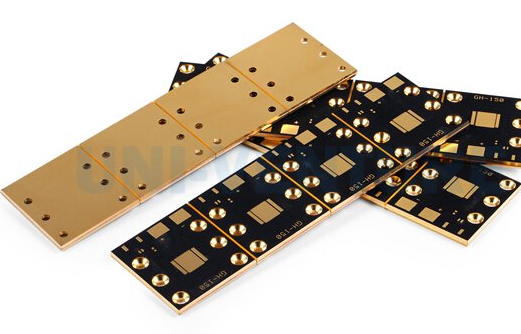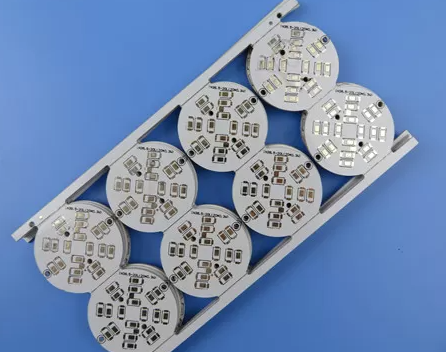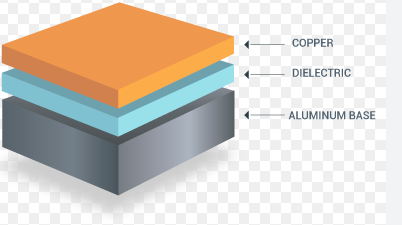Single sided metal core pcb
Advantages Of Single Sided Metal Core PCBs In LED Applications
Single-sided metal core printed circuit boards (PCBs) have become increasingly popular in LED applications due to their unique advantages. These PCBs, which feature a metal core typically made of aluminum or copper, offer several benefits that make them particularly well-suited for use in LED lighting systems.
One of the primary advantages of single-sided metal core PCBs in LED applications is their superior thermal management capabilities.
LEDs generate a significant amount of heat during operation, and effective heat dissipation is crucial to maintaining their performance and longevity. The metal core in these PCBs acts as a heat sink, efficiently conducting heat away from the LED components and dissipating it into the surrounding environment.
This helps to prevent overheating, which can lead to reduced efficiency, color shift, and even premature failure of the LEDs.
In addition to their thermal management properties, single-sided metal core PCBs also offer enhanced mechanical stability. The metal core provides a robust and durable foundation that can withstand the stresses and strains associated with LED applications.
This is particularly important in environments where the lighting systems are subject to vibration, shock, or other mechanical forces.
The increased stability helps to ensure the reliability and longevity of the LED system, reducing the need for frequent maintenance and replacement.
Another significant advantage of single-sided metal core PCBs is their ability to support higher power densities.
The efficient heat dissipation provided by the metal core allows for the use of higher power LEDs without the risk of overheating. This enables the design of more powerful and compact LED lighting systems, which can be particularly beneficial in applications where space is limited or where high-intensity lighting is required.
Furthermore, the use of single-sided metal core PCBs can lead to cost savings in LED applications.
The improved thermal management and mechanical stability can reduce the need for additional cooling mechanisms, such as heat sinks or fans, which can add to the overall cost and complexity of the lighting system. Additionally, the enhanced reliability and longevity of the LED system can result in lower maintenance and replacement costs over time.
Moreover, single-sided metal core PCBs offer design flexibility, allowing for the creation of custom shapes and sizes to meet the specific requirements of various LED applications. This flexibility can be particularly advantageous in the development of innovative lighting solutions, such as curved or flexible LED panels, which can be used in a wide range of applications, from automotive lighting to architectural illumination.
In conclusion, single-sided metal core PCBs provide several key advantages in LED applications, including superior thermal management, enhanced mechanical stability, support for higher power densities, cost savings, and design flexibility. These benefits make them an ideal choice for a wide range of LED lighting systems, helping to ensure optimal performance, reliability, and longevity. As the demand for efficient and high-performance LED lighting continues to grow, the use of single-sided metal core PCBs is likely to become even more prevalent, driving further innovation and advancement in the field of LED technology.

Thermal Management Solutions With Single Sided Metal Core PCBs
Single-sided metal core printed circuit boards (PCBs) have emerged as a pivotal solution in the realm of thermal management for electronic devices. As electronic components continue to shrink in size while increasing in power density, efficient heat dissipation becomes crucial to maintain performance and reliability. Single-sided metal core PCBs, with their unique construction, offer an effective means to address these thermal challenges.
At the heart of a single-sided metal core PCB is a metal substrate, typically aluminum or copper, which serves as the foundation for the circuit.
This metal core is sandwiched between a dielectric layer and the conductive copper layer where the circuit traces are etched. The metal core’s primary function is to act as a heat sink, drawing heat away from the components and dissipating it efficiently. This is particularly beneficial in high-power applications where traditional FR4 PCBs may fall short in managing thermal loads.
One of the key advantages of single-sided metal core PCBs is their ability to enhance thermal conductivity.
The metal core provides a direct thermal path from the heat-generating components to the heat sink, significantly reducing thermal resistance. This efficient heat transfer mechanism ensures that components operate within their optimal temperature range, thereby extending their lifespan and improving overall system reliability. Moreover, the enhanced thermal performance can lead to higher power handling capabilities, making these PCBs ideal for applications such as LED lighting, power supplies, and automotive electronics.
In addition to superior thermal management, single-sided metal core PCBs offer mechanical robustness.
The metal substrate imparts structural integrity, making the PCB more resistant to mechanical stresses and vibrations. This durability is particularly advantageous in harsh environments where electronic devices are subjected to physical shocks and temperature fluctuations. Consequently, single-sided metal core PCBs are often employed in industrial and automotive sectors where reliability and longevity are paramount.
Furthermore, the design flexibility of single-sided metal core PCBs allows for innovative thermal management solutions.
For instance, designers can incorporate thermal vias, which are plated holes that connect the top copper layer to the metal core, further enhancing heat dissipation. Additionally, the metal core can be selectively exposed to create mounting points for heat sinks or other cooling mechanisms, providing tailored thermal solutions for specific applications.
Despite their numerous benefits, it is essential to consider certain factors when designing with single-sided metal core PCBs.
The choice of metal core material, thickness, and dielectric layer properties must be carefully evaluated to meet the thermal and mechanical requirements of the application. Additionally, the manufacturing process for these PCBs can be more complex and costly compared to traditional FR4 PCBs. However, the long-term benefits in terms of performance, reliability, and lifespan often justify the initial investment.
In conclusion, single-sided metal core PCBs represent a significant advancement in thermal management solutions for modern electronic devices. Their ability to efficiently dissipate heat, coupled with mechanical robustness and design flexibility, makes them an attractive choice for high-power and high-reliability applications. As electronic devices continue to evolve, the role of single-sided metal core PCBs in ensuring optimal performance and longevity will undoubtedly become increasingly important.

Manufacturing Process Of Single Sided Metal Core PCBs
The manufacturing process of single-sided metal core printed circuit boards (PCBs) involves several meticulous steps, each crucial to ensuring the final product meets the desired specifications and performance standards. Initially, the process begins with the selection of the metal core material, typically aluminum or copper, chosen for its excellent thermal conductivity and mechanical stability. This core serves as the foundation upon which the PCB will be built, providing both structural support and efficient heat dissipation.
Following the selection of the metal core, the next step involves the application of an insulating layer.
This layer, often made from a dielectric material, is essential for electrically isolating the conductive copper traces from the metal core. The dielectric material is carefully chosen to balance thermal conductivity and electrical insulation properties, ensuring optimal performance of the PCB. The insulating layer is typically applied through a lamination process, where the dielectric material is bonded to the metal core under heat and pressure.
Once the insulating layer is in place, the copper foil is laminated onto the dielectric layer.
This copper foil will form the conductive traces of the PCB. The lamination process involves pressing the copper foil onto the dielectric layer under controlled temperature and pressure conditions, ensuring a strong and uniform bond. After lamination, the copper foil is cleaned and prepared for the next stage of the manufacturing process.
The subsequent step is the application of a photoresist layer onto the copper foil.
This photoresist is a light-sensitive material that will be used to define the pattern of the conductive traces. The photoresist is applied uniformly across the surface of the copper foil, and then the PCB is exposed to ultraviolet (UV) light through a photomask. The photomask contains the desired circuit pattern, and the UV light hardens the photoresist in the exposed areas, while the unexposed areas remain soft and can be easily removed.
After exposure, the PCB undergoes a development process where the unexposed photoresist is washed away, revealing the underlying copper. The remaining hardened photoresist protects the copper traces that will form the circuit. The next step is the etching process, where the exposed copper is removed using a chemical etchant, typically ferric chloride or ammonium persulfate. This etching process leaves behind the desired copper traces, which are protected by the hardened photoresist.
Following the etching process, the remaining photoresist is stripped away, leaving only the copper traces on the insulating layer.
At this stage, the PCB undergoes a thorough cleaning process to remove any residual chemicals and contaminants. The cleaned PCB is then inspected for any defects or irregularities in the copper traces, ensuring that the circuit pattern is accurate and free from flaws.
The final steps in the manufacturing process involve the application of a protective solder mask and the addition of surface finishes.
The solder mask, typically a green epoxy material, is applied over the entire surface of the PCB, except for the areas where components will be soldered. This solder mask protects the copper traces from oxidation and prevents solder bridges during the assembly process. Surface finishes, such as HASL (Hot Air Solder Leveling) or ENIG (Electroless Nickel Immersion Gold), are then applied to the exposed copper pads to enhance solderability and protect against corrosion.
In conclusion, the manufacturing process of single-sided metal core PCBs is a complex and precise series of steps, each contributing to the overall quality and performance of the final product. From the selection of materials to the application of protective layers, every stage is carefully controlled to ensure that the PCB meets the stringent requirements of modern electronic applications.

Cost-Effectiveness Of Single Sided Metal Core PCBs In Power Electronics
Single-sided metal core printed circuit boards (PCBs) have emerged as a cost-effective solution in the realm of power electronics, offering a unique blend of thermal management, mechanical stability, and economic efficiency. These PCBs are designed with a metal core, typically aluminum or copper, which serves as a heat sink to dissipate heat away from critical components. This characteristic is particularly advantageous in power electronics, where managing heat is crucial to maintaining performance and reliability.
One of the primary reasons single-sided metal core PCBs are cost-effective is their simplified design and manufacturing process.
Unlike multi-layer PCBs, which require complex fabrication techniques and multiple layers of materials, single-sided metal core PCBs consist of a single conductive layer on one side of the metal core. This straightforward structure reduces the number of manufacturing steps, thereby lowering production costs. Additionally, the use of a single conductive layer minimizes the amount of raw materials needed, further contributing to cost savings.
Moreover, the thermal conductivity of the metal core significantly enhances the performance and longevity of power electronic devices.
Efficient heat dissipation prevents overheating, which can lead to component failure and reduced lifespan. By maintaining optimal operating temperatures, single-sided metal core PCBs help ensure the reliability and durability of power electronic systems. This reliability translates into lower maintenance costs and fewer replacements, offering long-term economic benefits.
In addition to their thermal management capabilities, single-sided metal core PCBs provide excellent mechanical stability.
The metal core offers a robust foundation that resists bending and warping, which is particularly important in applications subject to mechanical stress or vibration. This durability reduces the likelihood of mechanical failure, thereby enhancing the overall reliability of the electronic device. Consequently, the reduced risk of mechanical damage can lead to lower repair and replacement costs, further underscoring the cost-effectiveness of these PCBs.
Furthermore, the integration of single-sided metal core PCBs into power electronics can lead to more compact and lightweight designs.
The efficient heat dissipation properties allow for higher power densities, enabling designers to pack more functionality into smaller spaces. This compactness can result in material savings and reduced shipping costs, as smaller and lighter devices are less expensive to transport. Additionally, the ability to create more compact designs can open up new market opportunities, as consumers increasingly demand smaller, more efficient electronic devices.
It is also worth noting that the environmental impact of single-sided metal core PCBs can be lower compared to traditional PCBs.
The reduced material usage and simplified manufacturing process can lead to less waste and lower energy consumption. As industries and consumers become more environmentally conscious, the adoption of more sustainable manufacturing practices can enhance the market appeal of products utilizing single-sided metal core PCBs.
In conclusion, the cost-effectiveness of single-sided metal core PCBs in power electronics is multifaceted, encompassing reduced manufacturing costs, enhanced thermal management, improved mechanical stability, and potential material and shipping savings. These advantages not only contribute to the economic efficiency of power electronic devices but also support their reliability and performance. As the demand for efficient and compact power electronics continues to grow, single-sided metal core PCBs are poised to play a crucial role in meeting these needs while offering significant cost benefits..







